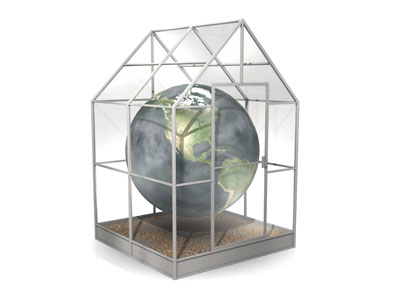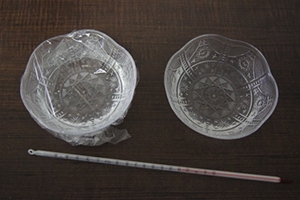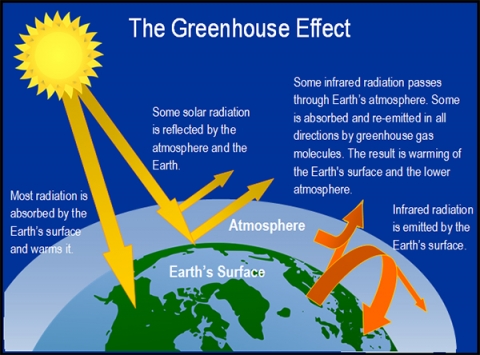What is the Greenhouse Effect?
How does this align with my curriculum?
Explore the greenhouse effect and learn about the impacts it can have on the environment.
What You Need
- Bowls - 2
- Water
- Plastic food wrap
- Bright light or a sunny day
- Thermometer
- Pen and paper
What to Do
- Fill both bowls with the same amount of water.
- Measure the temperature of the water in each bowl. Record it on a piece of paper.
- Cover one of the bowls with plastic food wrap.
- Place both bowls under a bright light source or in the sun.
- Make a prediction on how you think the temperature will change in each bowl.
- After an hour, measure the temperature of the water in each bowl. Record again. How has the temperature changed in each bowl?
Discovery
The plastic wrap acts like carbon dioxide in the atmosphere trapping most of the heat energy that would otherwise escape. Then, the heat energy from the air (a gas) is being transferred to the water (a liquid), which warms up the water.
Figure 1: Earth's "greenhouse effect”.
The Earth absorbs some of the energy it receives from the sun and radiates the rest back toward space. However, certain gases in the atmosphere, called greenhouse gases, absorb some of the energy radiated from the Earth and trap it in the atmosphere. These gases essentially act as a blanket, making the Earth’s surface warmer than it otherwise would be. While this greenhouse effect occurs naturally, making life as we know it possible, human activities in the past century have substantially increased the amount of greenhouse gases in the atmosphere, causing the atmosphere to trap more heat and leading to changes in the Earth’s temperature.
Increasing the amount of carbon dioxide in our atmosphere may heat the Earth by a few degrees Celsius which is sufficient to create huge changes in polar ice caps, plant and animal life and weather systems. If the massive ice caps that cover the north and south poles melt even a little, huge amounts of water would be released into the oceans. The increase in water level would have serious effects on coastal populations of plants and animals and land forms.
- What effect did the plastic wrap have on the temperature of the water? Investigate what will happen to the temperature if you cover one bowl with two layers of plastic wrap.
- Do a search on the internet to find out about the atmosphere on the planet Venus. Why do you think the temperature on the planet Venus is so high?
For more information on this topic check out these Let's Talk Science resources:
- What are greenhouse gases? (Backgrounders) - This backgrounder explains what greenhouse gases are and how they contribute to climate change.
- Cows, Methane, and Climate Change (STEM in Context) - How do beef and dairy cows contribute to climate change? Livestock agriculture is a source of methane, a powerful greenhouse gas.
- Understanding the Nitrogen Cycle? (STEM in Context) - What is the nitrogen cycle? How do human activities such as using fertilizer affect the nitrogen cycle? How can this cause greenhouse gases?
What’s happening?
The plastic wrap acts like carbon dioxide in the atmosphere trapping most of the heat energy that would otherwise escape. Then, the heat energy from the air (a gas) is being transferred to the water (a liquid), which warms up the water.
Figure 1: Earth's "greenhouse effect”.
The Earth absorbs some of the energy it receives from the sun and radiates the rest back toward space. However, certain gases in the atmosphere, called greenhouse gases, absorb some of the energy radiated from the Earth and trap it in the atmosphere. These gases essentially act as a blanket, making the Earth’s surface warmer than it otherwise would be. While this greenhouse effect occurs naturally, making life as we know it possible, human activities in the past century have substantially increased the amount of greenhouse gases in the atmosphere, causing the atmosphere to trap more heat and leading to changes in the Earth’s temperature.
Why does it matter?
Increasing the amount of carbon dioxide in our atmosphere may heat the Earth by a few degrees Celsius which is sufficient to create huge changes in polar ice caps, plant and animal life and weather systems. If the massive ice caps that cover the north and south poles melt even a little, huge amounts of water would be released into the oceans. The increase in water level would have serious effects on coastal populations of plants and animals and land forms.
Investigate further
- What effect did the plastic wrap have on the temperature of the water? Investigate what will happen to the temperature if you cover one bowl with two layers of plastic wrap.
- Do a search on the internet to find out about the atmosphere on the planet Venus. Why do you think the temperature on the planet Venus is so high?
For more information on this topic check out these Let's Talk Science resources:
- What are greenhouse gases? (Backgrounders) - This backgrounder explains what greenhouse gases are and how they contribute to climate change.
- Cows, Methane, and Climate Change (STEM in Context) - How do beef and dairy cows contribute to climate change? Livestock agriculture is a source of methane, a powerful greenhouse gas.
- Understanding the Nitrogen Cycle? (STEM in Context) - What is the nitrogen cycle? How do human activities such as using fertilizer affect the nitrogen cycle? How can this cause greenhouse gases?


